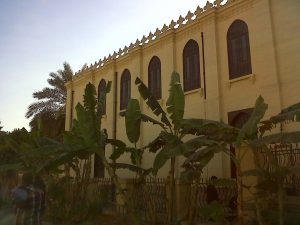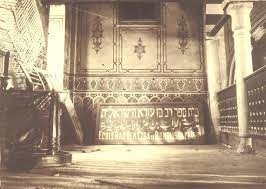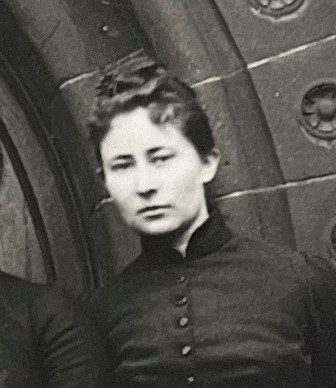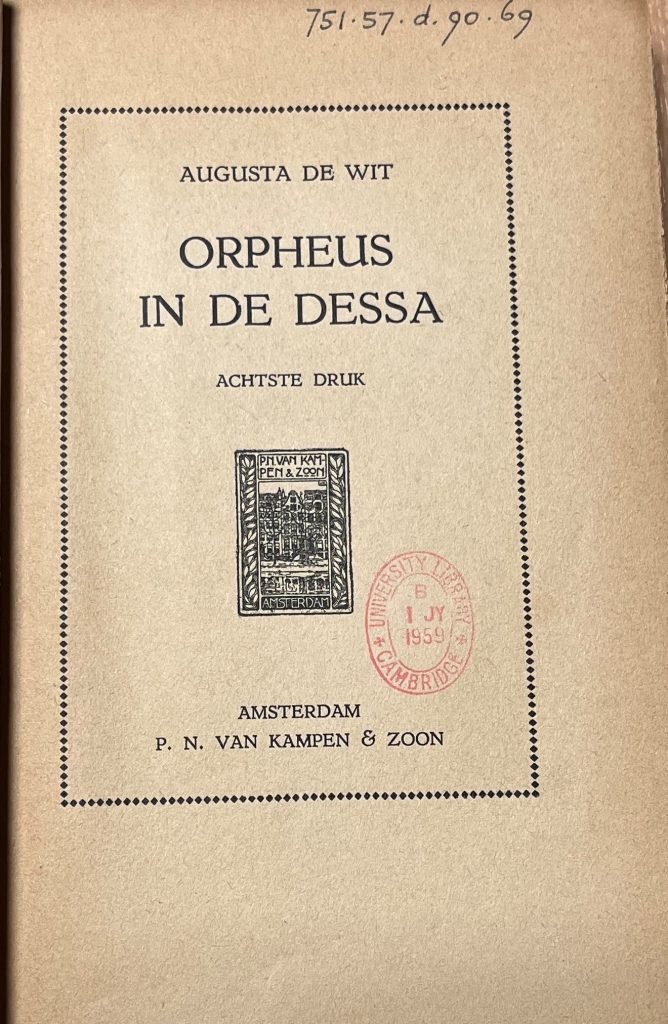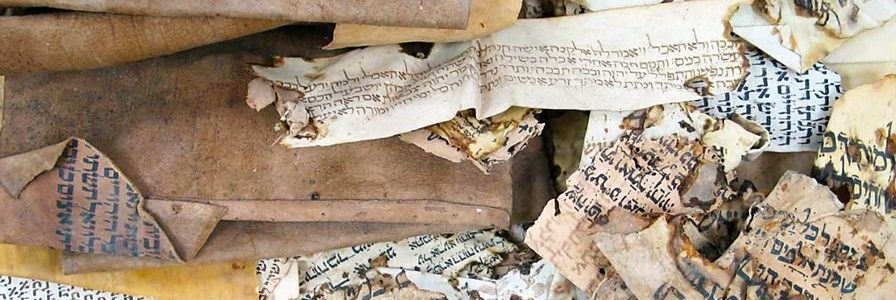
Augusta de Wit and the Genizah hoard
The discovery of the Cairo Genizah manuscript fragments in the synagogue in Al-Fustat, Old Cairo, has already been well documented. In January 1897, Solomon Schechter, the Cambridge rabbinical scholar, made his first visit to the synagogue subsequent to information given to him by the twin sisters Agnes Lewis and Margaret Gibson that these texts, stored there over centuries, could be of unexpected interest. The twins had visited Cairo briefly the previous year prior to the start of an expedition to look for manuscripts in Cairo and Jerusalem. On their return to Cambridge, they had, with Schechter, identified among them a copy of the long-lost Hebrew text of Ecclesiasticus.
Alerted by this find, Schechter had arrived in Cairo in late 1896. He spent some time persuading the local Chief Rabbi, Aaron Raphael Ben-Shim’on, to give him permission to enter the sacred genizah enclosure high up in the wall of the Ben Ezra Synagogue to investigate the contents.
On this very first visit to view the Genizah collection, Schechter was not alone, but accompanied by the sisters Agnes and Margaret, the inveterate travellers and scholars, who were making a brief visit to Cairo before setting out on their fourth trip to St Catherine’s Monastery in Sinai to carry out further manuscript research. Also mentioned in the record of the Genizah discovery, is a Miss Augusta de Wit, who had apparently been invited by Schechter to join the party. She is first mentioned by Agnes Lewis in her travel narrative In the Shadow of Sinai, published in 1898 and which describes this particular expedition. Here Agnes gives a detailed description of the visit made with her sister, Schechter and Miss de Wit to see the Genizah fragments in their original home.
Inside the Synagogue, the opening to the Genizah chamber was high up in the end wall with access via a rickety ladder which had its rungs widely-spaced. Schechter bravely mounted the ladder and jumped down into the enclosure beyond, landing on the dusty fragments of parchment and paper below. He was closely followed by Margaret, but Agnes, usually the more extrovert sister, did not attempt this exercise as she had recently suffered from a serious bout of rheumatism which had almost put paid to the whole trip to Cairo. Agnes mentions that after Schechter and Margaret entered the sacred enclosure ‘so did Miss de Wit, a Girton student, whom Dr Schechter had invited’. There is a mystery here as it is unclear if Miss de Wit was a friend of the sisters or of Schechter and how they had come to know each other.
Augusta de Wit had been a student at Girton College in Cambridge and it is from the College Archives that more details of her life can be discovered. Augusta Anna Henrietta de Wit, was born in Sibolga, Sumatra, in 1864. She was the daughter of Jan Karel de Wit colonial Resident of Dutch Timor. Her mother was French and her parents sent Augusta back to Europe for her education, beginning her studies in the Netherlands at the University of Utrecht. She then moved to England to study at Bedford College in London and subsequently, in 1889-90, at Girton. She appears to have been quite a tall young woman and appears in the back row of the Girton Matriculation photograph for the year 1889.
With her multicultural background, languages were Augusta’s skill and she wrote easily in English, French, Dutch, German and Italian. At Girton she read modern languages and she is listed in the Girton Review of August 1890, as having gained a first class pass in the Intercollegiate exams in Medieval and Modern Languages. There is no record of her having subsequently taken the Medieval and Modern Languages Tripos exam which had been instituted by the University in 1886, and was taken by many women students.
The reason for Augusta’s presence in Cairo in early 1897 with Schechter and the twins remains unclear, but possibly the sisters had invited Augusta to travel with them to Cairo. Had they met Augusta on a previous occasion? In the Girton College Council Minutes for 1889 it records that Margaret Gibson had recently been in contact with the Mistress of the College, Miss Welsh, with an offer of funding to set up an annual essay prize on the subject of the Greek New Testament which was gratefully accepted. So, Margaret was already in contact with Girton at the time Augusta was a student there; her essay prize offer is recorded in the Minutes on the page before listing Augusta’s acceptance as a student. It is also possible that she was originally a friend of the Schechters’. Solomon and his wife Mathilde settled in Cambridge in 1890. Solomon, with his extrovert character and made a wide circle of friends. Mathilde, with her very sociable disposition, gathered around herself a group of scholarly, independent and literary women in the University, so perhaps Augusta who was resident in Cambridge at the time, was among them.
Precise information on Augusta’s life after her studies at Girton is difficult to find. She appears to have lived at different times in the Netherlands and in Indonesia and must have been, from early in life, a seasoned traveller. She became a teacher for some years at a school in Utrecht and later in Batavia (now Jakarta) but eventually abandoned this venture to concentrate on writing. She worked for a time as a journalist on the Straits Times, published from Singapore. She also published books focusing on the region of her birth including Facts and Fancies about Java which was first published in 1896. Augusta had great sympathy with the native inhabitants of Malaya, Sumatra and Java and it could be said that her descriptions were early anthropological studies of these cultures. She also wrote novels in Dutch, one of which, Orpheus in de dessa (Orpheus in the Highlands), published in 1906, became a set text in Dutch schools. Island India (published in 1914) was a collection of tales and sketches written in English. Her writing, to the modern reader, has a very colonial feel which sits uncomfortably with current thinking. Yet she also shows genuine interest and sympathy for the Javanese, among whom she must have travelled in the early part of her life.
In her published works, such as Facts and Fancies in Java, Augusta illustrates her texts with photographs, many of which are now in museum collections in the Netherlands, but many are unattributed. Possibly these were Augusta’s own photographs and they share much in style with those of the twin sisters and are from the same era. Agnes and Margaret had learned photography to produce copies of manuscripts in St Catherine’s Monastery – possibly the very first manuscript digitization project – but they also photographed scenery and people. So perhaps Augusta shared yet another common interest here with the twins, though Agnes admitted they had regretfully forgotten to take their camera with them on their visit to the genizah chamber.
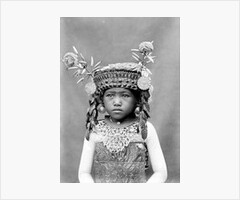
In 1897, after the visit to the Genizah chamber, the four explorers departed in different directions. After loading the manuscript fragments from the Genizah into sacks to be transported back to Cambridge, Schechter went on to Palestine to visit his twin brother, and then sailed back to England on a ship where he met the archaeologist Professor Flinders Petrie. This ship hit rocks off the French coast but all aboard returned home safely.
Agnes and Margaret travelled to Suez, and for the first time, instead of making their way to St Catherine’s overland by camel, they took the steamer, first class, on a Khedivial Mail Steamship & Graving Dock Company ship. They sailed to El Tor on the North bank of the Red Sea and then proceeded overland to the Monastery, shortening their journey by some days.
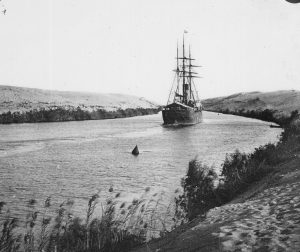
Possibly Augusta de Wit travelled with them at least as far as Suez, three women with many common interests choosing to share the journey. Here Augusta would have been able to board ship as part of the longer sea journey further East and back to her birthplace in Sumatra. Schechter and the sisters all returned to Cambridge to begin sorting and listing the manuscript fragments which became the Taylor-Schechter Genizah collection, work which continues to this day.
It is unknown if Augusta ever returned to Cambridge or kept in touch with the friends she had made there. Her life took a different course and she appears to have divided her time in later life between Indonesia and the Netherlands, becoming a well-known writer of liberal political views, and it is there that she died in Baarn, in 1939 at the age of 74.
References
Girton College Roll file 1889
Girton Review, August 1890, 3
Girton Review. Michaelmas Term 1939, 42-4
Girton College. Minutes of the Executive Committee. Vol. XI, 125-7
Hoffman, A. and Cole, P. Sacred trash. Nextbook. 2011
Lewis, Agnes. In the Shadow of Sinai; a story of travel and research from 1895 to 1897. Alpha Press, reprinted 2020
Reif, Stefan. A Jewish archive from Old Cairo: the history of Cambridge University’s Genizah collection. Curzon, 2000
Reif, Stefan. Giblews, Jews and Genizah Views. Journal of Jewish Studies, 2004, LV (2) 332-346
Soskice, Janet. Sisters of Sinai; how two lady adventurers found the hidden Gospels. Vintage, 2009
Sisters of Sinai Travel Lantern Slides (Cambridge, Westminster College, WGL4/6-15)

